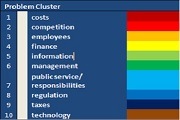





 "...small-medium sized businesses (SME), public sector entities, the
communities in which they operate, and society at large are exposed to
many factors that are outside the control of executives and policy
makers. These exposures span a variety of influences ranging from
commodity and financial market prices, macroeconomic conditions,
operational disruptions, human misconduct, technological shifts,
competitor moves, sociopolitical events, natural hazards, man-made
disasters, etc.
"...small-medium sized businesses (SME), public sector entities, the
communities in which they operate, and society at large are exposed to
many factors that are outside the control of executives and policy
makers. These exposures span a variety of influences ranging from
commodity and financial market prices, macroeconomic conditions,
operational disruptions, human misconduct, technological shifts,
competitor moves, sociopolitical events, natural hazards, man-made
disasters, etc.
Each of these risk areas are addressed through
rather disparate practices of financial risk analysis, exposure limits,
actuarial modeling, insurance contracting, alternative risk-transfer,
contingency planning, risk mitigation, preparedness, etc. Business
enterprise and society are also faced with potential systemic risks
embedded in interacting global markets, worldwide climatic changes, and
threats of international terrorism. All of this accentuates a need for
effective strategic risk management practices to deal with these
phenomena both at corporate management and public policy levels."
* Strategic Risk
Management (SRM) - Outlining the Contours of the New Risk Management
Paradigm by Torben Andersen, Associate Professor, Copenhagen Business
School
The objective of MERA is to provide SME's a self assessment
tool to score and manage macroeconomic and event risks that impacts the
profitability and growth of SMEs. These risk factors pose challenges
and offer opportunities presented by rapidly changing business
conditions and market dislocations. MERA sizes macroeconomic and event
risks; allowing users to initiate actions to mitigate threats and
initiate actions to capitalize on the opportunities volatile business
cycles present.
This app offers a self assessment framework for users to score risk clusters that are often overlooked by SME business managers.
The
National Federation of Independent Businesses (NFIB) details over 75
macro risk factors confronting SMEs. MERA includes these factors as
well as others for assessment consideration. Users may also enter user
defined factors. Risk factors are color coded and grouped in 10
Problem Clusters. That include:
costs
competition
employees
finance
information
management
public service/ responsibilities
regulation
taxes
technology
MERA 2.3 includes a series of 70 Key Performance Indicators (KPI) for SMEs.
The KPIs are grouped into 5 areas.
Best Practice Indicators
Employee Indicators
Product Indicators
Financial Indicators
Corporate Matters
MERA's
rating scheme allows users to score risk factors and its impact on
business. Users define actions that will mitigate risk factors,
estimate capital investments required to address risk and calculate a
ROI to determine project priorities, funding requirements and expected
returns.
MERA aggregates and scores macro enterprise risk ,
aligns actions and capital investments required to mitigate aggregated
macroeconomic and event risk factors confronting the enterprise.
Android
users require the use of Mobile Office. Many Mobile Office conversion
apps are available for download on Google Play. A PDF reader and a Zip
File Manager are also required to use this app; also widely available
for no charge on Google Play. The app directs users to a Drop Box to
pick up a zip file.Sum2 does not collect or store any data entered into our Mobile Business apps. All data entry is done off line.
Price: $3.00
Sum2, LLC
PO Box 665
Oakland, NJ 07436
201.919.7536
customer.service@sum2.com
© 2002-2017 Sum2 LLC, All Rights Reserved